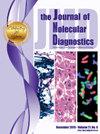评估突变发现方法中不一致的体细胞呼叫,以尽量减少假阴性耐药结果。
IF 3.4
3区 医学
Q1 PATHOLOGY
引用次数: 0
摘要
当利用全外显子组测序(WES)进行治疗决策时,评估体细胞突变检测的稳健性是必不可少的。使用来自fda主导的测序质量控制第二阶段(SEQC2)项目的肿瘤WES进行了全面评估,其中多个文库试剂盒在三个实验室对相同的DNA材料进行了测序,以基准分析有效性。这些工作流程包括各种读取对齐器(BWA, Bowtie2, DRAGEN-Aligner, DRAGMAP和HISAT2)和突变调用器(Mutect2, TNscope, DRAGEN-Caller和DeepVariant)组合。结果表明,DRAGEN检测SNV和INDEL的平均f1得分分别为0.966和0.791,具有较好的性能。在开源软件中,BWA Mutect2和HISAT2 Mutect2组合SNV和INDEL的平均f1得分最高,分别为0.949和0.722。分析表明,高质量的数据可以被分析为具有较差的结果,反之亦然。对COSMIC报告的突变的评估揭示了富集试剂盒之间的差异。IDT富集试剂盒假阴性率较高,而安捷伦WES试剂盒容易漏检CBL和IDH1突变,罗氏文库试剂盒容易漏检PIK3CB突变。对于药物相关的生物标志物,Sentieon TNscope倾向于低估肿瘤突变负担,忽视关键的耐药突变,如FLT3 (c.G1879A: p.A627T)用于白血病的阿糖胞苷耐药,MAP2K1 (c.G199A:p.D67N)用于黑色素瘤的BRAF抑制剂。这些发现强调了强大的生物信息学分析在识别肿瘤突变和指导临床决策方面的重要性。本文章由计算机程序翻译,如有差异,请以英文原文为准。

Evaluating Discordant Somatic Calls Across Mutation Discovery Approaches to Minimize False-Negative Drug-Resistant Findings
Evaluating robustness of somatic mutation detections is essential when using whole-exome sequencing (WES) for treatment decision-making. A comprehensive evaluation was conducted using tumor WES from the US Food and Drug Administration–led Sequencing Quality Control Phase 2 project, in which multiple library kits sequenced identical DNA materials across three laboratories to benchmark analytical validity. These workflows included various read aligner (BWA, Bowtie2, DRAGEN-Aligner, DRAGMAP, and HISAT2) and mutation caller (Mutect2, TNscope, DRAGEN-Caller, and DeepVariant) combinations. The results revealed that DRAGEN exhibited superior performance, achieving mean F1 scores of 0.966 and 0.791 for single-nucleotide variant and insertion/deletion detection, respectively. Among open-source software, BWA Mutect2 and HISAT2 Mutect2 combinations showed the highest mean F1 scores for single-nucleotide variant (0.949) and insertion/deletion (0.722), respectively. The analyses indicated that high-quality data can be analyzed as having worse results, and vice versa. Evaluations of Catalog of Somatic Mutations in Cancer reported mutations unveiled discrepancies across enrichment kits. Integrated DNA Technologies enrichment kits showed a higher false-negative rate, whereas Agilent WES kits tended to miss mutations in CBL and IDH1, and Roche library kits tended to miss the mutations in PIK3CB. Sentieon TNscope tended to underestimate tumor mutation burden and overlook FLT3:c.G1879A for cytarabine resistance in leukemia and MAP2K1:c.G199A for BRAF inhibitors in melanoma. The findings highlight the importance of robust bioinformatic analysis in guiding clinical decision-making.
求助全文
通过发布文献求助,成功后即可免费获取论文全文。
去求助
来源期刊
CiteScore
8.10
自引率
2.40%
发文量
143
审稿时长
43 days
期刊介绍:
The Journal of Molecular Diagnostics, the official publication of the Association for Molecular Pathology (AMP), co-owned by the American Society for Investigative Pathology (ASIP), seeks to publish high quality original papers on scientific advances in the translation and validation of molecular discoveries in medicine into the clinical diagnostic setting, and the description and application of technological advances in the field of molecular diagnostic medicine. The editors welcome for review articles that contain: novel discoveries or clinicopathologic correlations including studies in oncology, infectious diseases, inherited diseases, predisposition to disease, clinical informatics, or the description of polymorphisms linked to disease states or normal variations; the application of diagnostic methodologies in clinical trials; or the development of new or improved molecular methods which may be applied to diagnosis or monitoring of disease or disease predisposition.

 求助内容:
求助内容: 应助结果提醒方式:
应助结果提醒方式:


